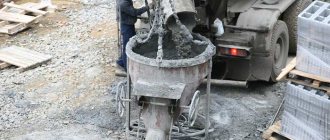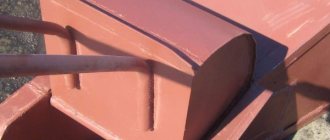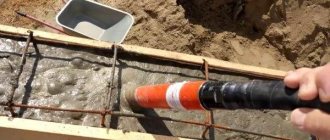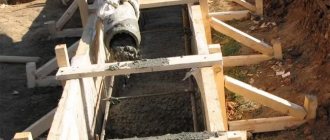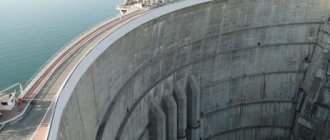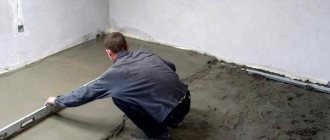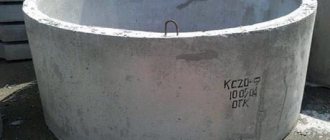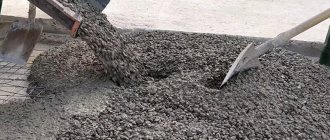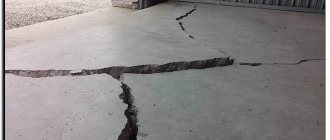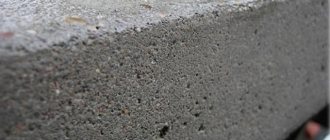How does concrete get into formwork?
One of the most critical stages in the construction of monolithic reinforced concrete structures is the delivery of concrete from the mortar-concrete unit to the place of its installation.
How concrete is delivered to the placement site Gone are the days when the concrete mixture was delivered to the construction site by dump trucks; now concrete is transported by domestic and imported concrete trucks of various capacities. Using this delivery method can significantly increase the life of concrete, since throughout the entire trip the mixing drum of the concrete truck rotates slowly (3 - 4 rpm), mixing the mixture, and almost fresh concrete arrives at the site. However, now the concrete mixture delivered to the construction site must be brought into place and poured into the formwork. Two main methods of supplying concrete are used here:• the traditional method: “crane-tub”, in which the concrete delivered to the construction site is poured into a rotating tub, laid in a horizontal position with the shutter closed. A construction crane turns the filled tub into a vertical position, lifts it and carries it to the place where it is poured into the formwork, where the shutter is opened and concrete is poured into the formwork;• a relatively new method of laying concrete using a concrete pump. In this case, the concrete mixture from a concrete truck is poured into the receiving hopper of a mobile (trailer) or truck-mounted concrete pump, which delivers the mixture directly into the formwork through concrete pipes. The power of modern concrete pumps allows the mixture to be supplied to a height of up to 100 m and a distance of up to 300 m. Both of these methods are used on domestic construction sites with equal success, and each of them has its own characteristics and, accordingly, areas of application.
Concrete pumps are high-performance modern equipment for laying concrete. Of course, the use of concrete pumps significantly reduces labor costs during concrete work, but its high productivity (up to 80 m³/hour) makes the use of such equipment economically justified only for significant volumes of concreting. At the same time, a situation may arise when it is necessary to concrete a structure to which the existing crane cannot supply concrete and it is necessary to either rent a crane with a long boom, which has a high lifting capacity with a large reach, in order to supply a bucket of concrete to this place, or use a concrete pump. In such a situation, a truck-mounted concrete pump can be used, which, thanks to a boom reaching a length of 60 m, can in a short time concrete a structure that is inaccessible to a construction crane of medium lifting capacity. For concreting large-area floors, mechanical or hydraulic mobile concrete dispensing booms are used, allowing the mixture to be supplied within a radius of 12 to 40 m from the boom installation point. At the same time, the use of concrete pumps has its own characteristics, in particular, the pumped concrete mixture should not contain aggregates with a fraction larger than 40 mm, in addition, the concrete must have a certain plasticity (cone slump) and it must be supplied continuously, otherwise the concrete pipes must be regularly cleaned of the mixture remaining on their walls. Despite these features, the use of concrete pumps significantly speeds up the process of laying concrete and allows concreting structures of significant volume in a limited time.
Which method should you choose? However, the “crane-tub” method, due to its simplicity and efficiency, is still successfully used on many construction sites, where the bulk of the construction is made up of structures with a relatively small volume, in particular multi-storey and individual residential buildings. For industrial construction or the construction of unique public centers or shopping complexes, it most often turns out to be economically justified to use a concrete pump. In any case, the method of supplying concrete, as well as the equipment and equipment necessary for this, must be selected at the stage of developing a concrete work project, taking into account economic and technological factors.
xn—-ptbbjegddbnkmk.xn--p1ai
Delivery of concrete mix (horizontal transport) in containers
The concrete mixture is delivered from the concrete plant to the concreting site in dump trucks and concrete trucks, in containers (tubs, bunkers) loaded onto flatbed vehicles or platforms of narrow- or broad-gauge railways, by belt conveyors, concrete pumps or pneumatic blowers.
Transportation in containers is one of the methods of transporting concrete mixture, ensuring its delivery without overload from the concrete plant to the place of placement in the structure. Buckets, bunkers, trolley bodies of various types and different capacities (from 0.33 to 6.4 m3) are used as containers. Buckets and bunkers are transported on flatbed vehicles and railway platforms along wide and narrow gauges.
From means of transport to the place where the concrete mixture is laid, containers are transported by cranes of various types and corresponding lifting capacity. The weight of a bucket of concrete mixture should not exceed the lifting capacity of the crane at maximum boom reach.
When transporting in tubs, bunkers and trolley bodies, the loss of mortar and cement laitance on the way is eliminated, the convenience of unloading and cleaning containers is ensured, their gradual emptying is ensured, which is necessary when concreting reinforced structures, the possibility of stratification of the concrete mixture on the way is reduced, and protection from atmospheric agents is improved. impact. However, this method of transportation requires a large number of containers and reduces the use of vehicle carrying capacity due to the tare weight.
The tubs are filled with concrete mixture directly from the supply bin (storage tank) of the concrete mixer. The volume of the bucket is taken as a multiple of the batch volume of the concrete mixer.
Recommended bucket capacities for concrete mixers of various capacities
| Indicators | Concrete mixer capacity by volume of finished batch, l | |||||
| 330 | 800 | 1600 | ||||
| Useful volume of the tub, m3 | 0,33 | 0,66 | 0,8 | 1,6 | 1,6 | 3,2 |
| Weight of concrete mixture in a bucket, t | 0,8 | 1,6 | 1,9 | 3,85 | 3,85 | 7,7 |
| Approximate weight of the tub, t | 0,15 | 0,2-0,4 | 0,5-0,8 | 0,8-1,4 | 0,8-1,4 | 1,0-1,7 |
| Weight of a bucket with concrete mixture, t | 0,95 | 1,8-2,0 | 2,4-2,7 | 4,7-5,2 | 4,7-5,2 | 8,7-9,4 |
To transport the concrete mixture when concreting reinforced concrete and concrete elements of small width, tipping buckets with a capacity of 0.33-0.66 m3, bunker buckets-trolleys, etc. are used. For concreting massive concrete and reinforced concrete structures - buckets with a capacity of 1.6-6.4 m3 with curtain roller or jaw shutter.
A cylindrical tub T-130 with a capacity of 1.6 m3 consists of a cylindrical body 1 with a lower conical part 2, equipped with a sector curtain-roller shutter 5, a frame used to install the tub during transportation, and a traverse for hanging on a crane hook.
| Tub T-130 with a capacity of 1.6 m3 |
| 1 - cylindrical part of the body, 2 - conical part of the body, 3 - window, 4 - supporting part, 5 - curtain-roller shutter, 6 - shutter lever |
The cylindrical frame is equipped with windows 3 for observing the exhaust valve 5. The valve 5 consists of two side sectors that rotate around hinges. The sectors are mutually connected at the bottom by rods on which rollers are mounted. A thick rubber gasket (curtain) is laid on the rollers.
At the top edge of the tub, a safety latch is attached to the hinge, which is applied to the opening lever 6 to prevent self-opening of the shutter 5. The tub is unloaded by releasing the safety latch and lowering the opening lever.
When the lever is lowered, the sector gate rollers come off the discharge hole, and the rubber gasket moves off the rollers, opening the hole of the required size. The bolt closes when the lever is lifted up, and at the end of the lift the safety latch is automatically secured to the lever. The rollers, rolling onto the rubber gasket from behind, gradually lift it, pressing it to the edges of the hole.
In hydraulic engineering construction, buckets with a capacity of 3.2 and 6.4 m3 with a jaw valve are also used, the technical characteristics of which are given below
Technical characteristics of buckets with jaw closures
| Indicators | Brands of buckets | |
| S-470 | S-385 | |
| Useful capacity, m3 | 3,2 | 6,4 |
| Outer diameter, m | 2,29 | 2,45 |
| Height of the tub with traverse, m | 2,37 | 3,30 |
| Bucket weight, t | ||
| empty | 1,05 | 1,90 |
| with mixture | 8,7 | 17,3 |
The S-470 tub has a capacity of 3.2 m3, is conical in shape and is more stable than the T-130 tub. The jaw shutter 2 of the tub is controlled by lever 5, which is lowered when opening.
| Tub S-470 with a capacity of 3.2 m3 |
| 1 - body, 2 - bolt, 3 - additional support, 4 - vibrator, 5 - bolt lever, 6 - safety latch, 7 - traverse |
Tub S-385 with a capacity of 6.4 m3 of cylindrical-conical shape. It differs from the S-470 tub in its larger volume due to the cylindrical extension and greater stability: the supporting structure consists of three posts and a lower support ring.
To speed up the unloading of low-moving concrete mixtures (with a cone draft of up to 4 cm), vibrators are attached to non-tipping buckets.
For concreting columns, beams, purlins, floors, coverings, thin walls and other structures, vibrating buckets with a capacity of 0.33 m3 are used. Vibrator 3, attached to the body of the tub 1, ensures unloading of the concrete mixture (with a cone draft of 5 cm) in 15 seconds. The intensity of unloading is controlled by sector gate 2.
| Vibrating tub with a capacity of 0.33 m3 |
| 1 - body, 2 - shutter, 3 - vibrator, 4 - traverse |
Vibrating buckets with a capacity of 0.66 and 0.8 m3 are used for concreting medium and massive foundations, powerful frame structures, retaining walls, etc.
Vibrating buckets are loaded at a concrete plant and delivered to the concrete structure by flatbed vehicles. Designs of vibratory buckets with a capacity of 0.33; 0.66 and 0.8 m3 are the same, they differ only in size.
Technical characteristics of vibrating buckets
| Indicators | Vibrating buckets with capacity, m3 | |
| 0,33 | 0.66 and 0.8 | |
| Dimensions, mm: | ||
| length | 1060 | 1466 |
| width | 890 | 1026 |
| height | 960 | 1360 |
| Bucket weight, t | ||
| empty | 0,14 | 0,28 |
| with concrete mixture | 0,93 | 1,86-2,20 |
When placing buckets on cars or on railway platforms, they usually leave free space for one bucket. Then, when unloading with a crane, the emptied tub is placed in a free place, then the loaded one is removed, etc. As a result, the downtime of transport during unloading is reduced. During mass laying of concrete mixture, the movement of trains with tubs is organized according to a schedule with a minimum duration of stops for unloading and loading. Due to the conditions of maneuverability, no more than four to five buckets are placed in a composition of one or two platforms. Trains with tubs stop at a crane, which one by one delivers the tubs for unloading into the building.
For small volumes of work, if the operation of vehicles is not economically justified, the concrete mixture is transported in bunker or scoop trolleys along a narrow track for a distance of no more than 200 m, or in motorized and manual trolleys along roller tracks for a distance of up to 100 m.
Bunker trolleys have bodies with a capacity of 0.9, full-rotating scoop trolleys - 0.5 m3. In the absence of such trolleys, trolleys with a body with a capacity of 0.75 m3 are used, which tip over to the side when unloading.
Buckets, bunkers or trolley bodies should be immediately cleared of any remaining concrete mixture after each emptying. Periodically, at least twice a shift, and during breaks in work of more than 1 hour, containers for portioned delivery must be cleaned and washed, for which special tub washing stations are installed, working around the clock if necessary.
technology-jbi.ru
Purpose and design of the “Shoe” concrete bucket
There are two forms of container design: rectangular and cone-shaped. The first form is a “Shoe” tub for concrete, the second is a “Glass”. The shape of the “shoe” is a rectangle turning into a cone and really resembles this type of shoe. The hopper is loaded in a horizontal position with the shutter closed and fixed, and transported and used in a vertical position. Hence its additional name - rotary bunker. The rotation is made using lifting mechanisms.
This device opens at the bottom of the cone using a lever system, which provides regulation of the dose of concrete solution. In addition, the locking mechanism has a lock that prevents spontaneous opening. A folding chute serves to guide the pouring; To deliver the concrete mixture to hard-to-reach places, a rubberized hose is connected.
The handle for opening the hopper is offset and this allows you to visually control the concreting process. The design is stable in any position. If necessary, an electric vibration motor is installed on the “shoe”, in the area of the cone. Then the tub can be used for transporting rigid concrete and dry mixes. The advantage of this design is that the loading height in a horizontal position is low and it is possible to load concrete mortar from any type of concrete mixer.
Manufacturing
The process of preparing the mortar is a labor-intensive construction operation. That is why the trough for preparing the batch should be highly durable and easy to use.
Let's consider one of the possible design options. For manufacturing you will need the following materials:
a metal sheet. It is advisable to use sheet steel measuring 1000x2000 mm, with a thickness of at least 1 mm, and having a zinc coating. The dimensions of the steel sheet may vary. The main thing is that the volume of the container corresponds to the assigned tasks;
Making a container for preparing a solution from sheet metal
- coniferous wood in the form of boards with a thickness of 30 to 50 millimeters. Prepare one board about 6 meters long, which will allow you to make a trough with dimensions of 1x2 m;
- nails for making a wooden frame or self-tapping screws for fixing steel sheets to boards.
When making a trough for concrete with your own hands, perform the work in the following sequence:
- Cut a solid six-meter board into 4 pieces: two pieces 2 meters long and two 1 meter long.
- Round the edges along the radius on two-meter workpieces, sawing off the corner fragments.
- Nail galvanized steel sheet to the straight parts of the prepared planks using nails.
- Bend the edges of the sheet at the level of the radius part and, using self-tapping screws, fix the meter-long boards.
- Additionally, secure the structural elements with self-tapping screws, which will increase the service life and ensure tightness.
Considering the small overall dimensions and weight, transporting such a container for concrete is not difficult. The radius shape of the sheet at the ends makes it easier to remove the finished solution and clean it. The tightness of the structure is achieved after the initial mixing, when the cement mortar seals small cracks. After the concrete mass hardens, water will not be able to flow out.
After the first batch, the trough will become almost airtight due to the filling of the cracks with concrete mortar
This design option is simple and allows the use of available building materials. Such a trough is a completely complete device for preparing concrete.
Some features of the operation of construction devices
As noted above, it does not always make sense to purchase a bucket; sometimes it is much easier to rent one or even use the services of transporting concrete, since doing the work yourself will require too much effort.
This applies to many jobs, for example, cutting reinforced concrete with diamond wheels without special equipment will take too much time and money, and diamond drilling of holes in concrete is a completely impossible task without expensive devices. It is much easier to use the services of professionals who will carry out the work quickly and efficiently.
The paint must be periodically renewed, as the layer is severely damaged during use.
Criterias of choice
From the description it follows that the simplest, therefore the most inexpensive, but quite capacious design are all types of “Boxes”. At the same time, the most convenient (from the point of view of transportation, loading and unloading and the ability to move bulk materials) tub is considered to be a rotating “Shoe”. “Ryumka” is recommended to be used in combination with small-scale mechanization equipment: chutes, concrete pumps and feed hoses.
In general, it makes sense to have at the construction site: a “Shoe”, a “Glass” and several “Boxes” of various capacities and designs, depending on the scale of the construction and the volume of planned concrete work.
1.1. Excavation
The choice of excavation method, the choice of excavator, its movement pattern and the type of face depend on the geometric dimensions of the building in plan, the type of foundations, their depth, the type and condition of the soil and a number of factors inherent in a particular object.
Some typical recommendations:
− it is advisable to develop soil for strip foundations of residential buildings without a basement using the trench method using excavators equipped with a backhoe, longitudinal penetrations along the main axes of the building;
− excavation of soil for strip foundations of residential buildings with a basement should be carried out using a continuous pit using excavators with a backhoe, longitudinal penetrations. Outside the boundaries of the foundations, a ramp with i = 15% is arranged into the pit;
− development of soil for the foundations of industrial buildings (two-, three-, four-bay) should be carried out using excavators with a backhoe, longitudinal penetrations. When the column spacing is 6 m - using the trench method with ramps; at a step of 12 m or more
develop the soil for each foundation in separate pits;
− excavation of the soil under the pile field (foundations on piles - grillages) should be carried out using a continuous pit with a ramp device. The dimensions of the pit should include: a) its widening from the design dimensions along each axis, depending on the pile driving pattern, the movement of the pile driving unit, and its type; b) an additional area in front of the exit for parking the pile driver when driving the last row (cluster) of piles upon completion of work.
Soil development is carried out with the construction of slopes, the steepness of which in soils of natural moisture is accepted according to SNiP 12-04-02 “Labor safety in construction” part 2. Construction production (Appendix 2). When determining the dimensions of a pit or trench below, it is necessary to take into account that the distance from the bottom of the slope to the edge of the foundation must ensure the movement of workers when performing work and must be at least 60 cm (Fig. 1).
Rice. 1. Determination of the dimensions of the pit, trench
When developing soil for a pile foundation, an additional expansion of the pit is provided (from 0.7 to 1.0 m) if the piles are fed from the edge into the pit by a pipelayer. Soil development with excavators equipped with a backhoe is usually carried out by longitudinal penetrations, end or side mining. The penetration width at which the most productive work of the excavator is achieved is determined as. The number of penetrations is determined by dividing the width of the pit at the top by the width of the penetration. It is preferable to adjust the width of the penetrations with a corresponding increase in their number.
1.2. Formwork work
The production of formwork should, as a rule, be carried out centrally in specialized factories or workshops. The most common type of universal-purpose formwork, collapsible small-panel formwork, is used for concreting a wide variety of structures. The formwork includes panels that support fastening and connection elements. The mass of individual elements does not exceed 50 kg. Frame construction panels can be made either entirely of metal, or combined, using wood, plywood, chipboards, and plastic as a deck. For concreting foundations for free-standing columns, various types of block formwork have become widespread. The installed formwork structure must be strong, stable, airtight and ensure compliance with the following general requirements:
− high quality concrete surface and minimal adhesion;
− ease of repair and replacement of failed elements;
− required strength, rigidity and stability under the influence of loads during concreting;
− required dimensional accuracy of monolithic structures;
− quick installation, dismantling and the possibility of re-positioning on a construction site.
studfiles.net
Advantages and disadvantages of designs
Each model has its own characteristics, pros and cons. Some fixed-type models use both vertical and horizontal methods of loading concrete. At the bottom of the hopper there is a tray, it is usually made in the shape of a cone. Despite the identical dimensions, the pyramidal container is higher, but it is more difficult to clean the inner surface of solution residues.
In small designs, the bottom tray is most often opened manually. Large containers use locking connections.
Rotary models are more expensive, but also more comfortable to use. When using a “shoe”, supplying the solution requires fixing the structure at the desired angle to the support, this makes the work easier. It is possible to adjust the speed of supply of the mixture from the container. This type of design is more versatile, with increased convenience provided by the large cross-sectional area for the funnel.
Among the disadvantages of the “shoe”, it is worth noting the possibility of loading concrete only in a horizontal plane using two methods - using a dump truck or special vehicles. Thus, the “bell/glass” design is simpler and cheaper, while the “shoe” design is functional and comfortable, but costs more. The first option is suitable for small volumes of work, the second is relevant when performing large-scale fills.
A bucket for supplying concrete is a convenient and functional device that greatly simplifies and speeds up the pouring of concrete at sites. Provided the correct choice and professional operation, the bunker will serve for a long time and faithfully.
Criteria for choosing containers for concrete
To ensure optimal performance of construction work, compliance with technology, and ease of use of the container, a number of the following factors must be taken into account:
the dimensions must be suitable for carrying out all necessary manipulations in specific conditions; the capacity should be optimally compared with the scale of the concreting work, so as not to cause delays and to prevent idleness of the finished mixture; when choosing a shoe, you need to make sure that the required equipment can be used, the equipment is equipped, as well as the methods of attaching the sleeve or funnel; it is important that the lifting capacity is sufficient to ensure increased safety on the construction site, but taking into account the characteristics of the crane used; It is recommended to choose a branded manufacturer that guarantees high build quality, durability and reliability of the design (it is worth paying attention to Zitrek products).
Renting or buying?
- large amount of work;
- a tight or round-the-clock work schedule that does not allow downtime;
- it is necessary to make some changes to the scheme, for example, to strengthen the frame;
- are engaged in commercial activities and often perform work related to concreting: pouring sites or constructing multi-story monolithic buildings.
If you decide to buy a new tub, you will receive the following benefits:
- the design will fully meet the declared characteristics: absence of hidden or obvious defects, deformation of the container;
- it will be possible to maintain the ideal condition of the metal by ensuring gentle operating conditions and timely maintenance;
- loading the exact volume of solution, since there will be no dry concrete adhering to the walls.
Buying a used tub is an excellent alternative to purchasing a new one due to the following benefits:
- at the same price it will be possible to get larger container sizes;
- instead of a fixed shoe, choose the optimal shoe and improve work productivity;
- abandon Chinese equipment in favor of branded equipment, for example, Zitrek;
- operation at the maximum technical capabilities with minimal financial investments.
Used equipment that has been in use for a year has a cost that is 1.5-2 times lower than new equipment with similar characteristics. Therefore, from a financial point of view, it is the most profitable. The following risks are present:
- ideal external condition is the result of hiding critical defects, for example, rusted sheets or a supporting frame;
- inside steel structures, as a result of improper operating conditions, fatigue deformations have formed, which, under certain loads of the concrete mixture, partially or completely destroy the tub;
- There must be a technical passport.
In case of a limited budget or one-time concreting, renting is beneficial. Its cost depends on the service life of the equipment, its condition, design features and equipment. If there is a long distance to the construction site, then it is necessary to evaluate the possibility of purchasing, since sometimes transportation costs can make renting financially unprofitable.
Prices for new and used concrete buckets
| Type of service | Type | Volume | Load capacity, t | Dimensions, m | Price, rubles |
| Purchase (new) | Fixed with unloading tray and funnel clamp | 0,5 | 1,12 | 1.50x1.50x1.46 | 18900 |
| 1,5 | 3,75 | 1.52x1.52x2.00 | 29950 | ||
| Fixed with tray | 3 | 4,5 | 1.57x1.57x2.85 | 48800 | |
| Rotating with a platform for installing a vibrator | 1,6 | 4 | 3.60x1.60x0.89 | 36900 | |
| 2 | 5 | 3.70x2.10x1.14 | 45400 | ||
| Purchase (used) | Rotary | 0,5 | 1,12 | 3.1x1.27x0.7 | 15500 |
| 1,6 | 3,75 | 3.10x1.27x1.20 | 16000 | ||
| 2 | 4,00 | 3.60x1.27x1.34 | 19500 | ||
| Fixed | 0,5 | 1,25 | 1.25x1.25x1.27 | 10000 | |
| 0,75 | 1,88 | 1.25x1.25x1.68 | 14500 | ||
| 2 | 5 | 1.58x1.58x2.45 | from 19000 | ||
| Rent | Rotary | 1 | 2,5 | 3.17x1.27x0.72 | from 800 per day + 12000 deposit |
| 2 | 5 | 3.64x1.27x1.34 | |||
| Fixed | 0,5 | 1,5 | 1.25x1.25x1.27 | from 500 per day + 10,000 deposit | |
| 1 | 2,5 | 1.25x1.25x1.86 | |||
| 2 | 5 | 2.00x2.00x1.75 |
Purpose and varieties
A tub may be needed when the volume of loading and unloading concrete is very large. When pouring monolithic foundations and other structures, the bunker makes it possible to significantly reduce the cost of delivering the finished mixture, eliminating the need for the services of a plant and providing the solution directly to the site. Ready concrete can be stored in the tub for some time.
Different models of buckets are suitable for implementing certain tasks, so before choosing, it is advisable to study the features of each option.
Glass or bell
This is a model of a fixed cylindrical tub with a cone. The bunker carries out vertical supply of concrete. The stability of the structure is achieved thanks to the presence of a support system in the format of wide rings. The rings are different, the configuration is different in the case of a filled and empty container.
The concrete solution is loaded into the bucket through the top from a dump truck. It's easiest to work with lowered models. The standard configuration assumes the presence of jaw-type locking connections, which are located in the lower part of the cone. Also, to simplify the supply of the solution, mechanisms are used: a trailed tray, a funnel, and fasteners for flexible hoses.
The “bell” model is used to load concrete mortar into similar/monolithic building structures. This type of tub is useful when working with very hard mixtures. Additional functionality is provided by replaceable trays and special hoses, without which concrete supply is only possible in one direction.
“Ryumka” is the simplest and most inexpensive version of a tub, the capacity varies in the range of 0.5-3 cubic meters (more can be found in Moscow, but rarely), the average carrying capacity is 2500 kilograms.
Tub in the shape of a shoe
This model is made with a rotating structure, the geometry of which can change. The capacity is 1-4 cubic meters, the hole for receiving concrete is rectangular, the mixture is unloaded horizontally, which guarantees comfort in operation and stability of the tub.
Externally, the model looks like a tapering and slightly truncated pyramid. The unloading funnel is closed with a special shutter, the body is reinforced with metal parts. The special frame provides additional protection and stability.
The main feature of the “shoe” model is the presence of a vibrator on either side of the tub, which significantly extends the life of the solution and allows it to be stored for a short time. The mixture becomes more homogeneous and active, and is easier to serve.
Cranes are used to move the tub and rotate it into a vertical plane. Thanks to the rotating type of design, the task is greatly simplified. This is a more functional model compared to the previous one. An important advantage is the connection of a vibrator, which does not allow concrete to linger on the walls of the container.
Discharge funnels in “shoe” type models can be very different – from slide to two-section. A system of levers initiates control. Using a bucket, concrete can be prepared directly on site.
Types of buckets for concrete
At this point in time, there are three types of buckets for supplying large volumes of concrete to places where it is directly used: “Shoe”, “Wine Glass” and “Mortar Box”. Let's take a closer look at the features of each device.
Rotary device for supplying concrete “Shoe”
The “Shoe” tub is a steel container with variable geometry, containing from 1 to 4 m3 of solution. The body of the container looks like a truncated pyramid, reminiscent of a woman's shoe. On one side of the container there is a rectangular hatch for loading concrete, and in the area of the top of the pyramid there is a hatch for unloading the solution, closed with a special sector shutter.
Main structural elements:
- The body is a welded structure made of sheet steel reinforced with steel channels. To allow movement, the “Shoe” body is equipped with two hinged welded eyes. On the top surface there is a platform for installing a vibrator. The vibrator is used for temporary storage of concrete and for cleaning the container from material residues;
- The shutter consists of two sections hinged. Each section has its own handle, fixed in the non-working position with a special ring. In some Shoe models, the shutter is opened and closed by a steering wheel;
- Section drive;
- Frame.
The “Shoe” is loaded in a horizontal position, and moved and unloaded in a horizontal position by appropriate lifting equipment, usually a tower crane.
Buckets for supplying concrete of the “Glass” design
The “Wine Glass” or “Bell” is a non-rotating, vertically standing structure. This is a bucket for universal-purpose concrete with a capacity of 0.5 to 3 m3 of material.
Main structural elements:
- Frame. It is a welded steel bunker for concrete consisting of a cylindrical and truncated conical part, only a truncated conical part, or a cylindrical and truncated pyramidal part. In this case, the cylindrical part is the loading hatch, and the truncated part of the cone or pyramid is the unloading hatch. In the upper part of the body there is a welded reinforcing ring belt made of a channel or two channels. There are 4 eyes welded along the perimeter of the belt for fastening the slings of the load-lifting device;
- Stand (support). It has a ring shape with 4 posts for welding the body. Made from channels;
- Tray attachment. Serves for supplying concrete to places of use or distribution into intermediate containers.
The main difference between the “Glass” and the “Shoe” is the same loading, transport and working position (vertical).
"Mortar box"
There are three types of configurations for this product: “Scoop Box”, “Boat Box” and “Trough Box”.
- The “scoop box,” depending on the dimensions and thickness of the steel sheet (2, 2.5 or 3 mm), has a capacity of 0.5 to 3 m3 of material. It is a welded rectangular structure, open at the top, reminiscent of a children's scoop. The side walls of the scoop are reinforced with corners, and the top has a reinforcing flange. Along the perimeter of the flange there are 4 welded eyes for movement. At the bottom of the rear wall there are 2 welded eyes for tilting the container;
- The “boat box”, depending on the dimensions and thickness of the steel sheet, has a capacity of 0.25 to 0.5 m3 of material. Structurally, it is a welded trough made of steel sheet made in the form of a truncated pyramid. Following the example of the top of the trough, there is a flange and 4 welded eyes for slinging and moving;
- A “trough box” generally has a capacity of 0.25-0.27 m3 of material. It has the shape of a welded trough with four or two upper welded eyes for movement.
Criteria for selecting buckets for supplying concrete
When purchasing a new product, pay attention to the following:
- For the desired capacity of the bunker: for buckets of the BN series it starts from 0.5 m3, for buckets of the BP series – from 1 m3. Volume gradation – every 0.2 m3.
- For the thickness of the metal of the bunker: rolled thin sheets will significantly reduce the service life of the product, taking into account the fairly high density of concrete mixtures and the operating conditions of the products at the construction site.
- On the quality of painting of all surfaces: the use of weather-resistant powder paints not only ensures the tightness of the coating in any atmospheric conditions (at least for a year), but also guarantees the durability of the equipment.
- For the presence of additional options in the design of the tub. In particular, the presence of a platform for installing a vibrator (for products such as a bell and a shoe) will speed up the process of unloading concrete and will reduce the complexity of subsequent cleaning of the internal surface of the bunker. For non-rotary versions, the convenience of unloading is also determined by the type of mechanism for opening the shutter jaws.
- Shape of transport eyes. It should be convenient for use when transporting the tub not only with cranes, but also with forklifts.
For periodic concrete work, buckets for pouring concrete are usually not purchased, but rented. The rented container must not have dents on the inner surface of the bunker, damage to the coating or defects in transport loops.
How to choose a tub?
The design of a concrete tub consists of metal fragments held together using a welding machine. A container with a volume of several m3, used to supply concrete, also has moving parts. When choosing a concrete bucket, you need to consider some points, in particular:
- ease of use and transportation of the product, pouring the solution and funnel (for a small volume of concrete mixture (0.5 m3), it is advisable to use a “shoe”);
- weight of the tub (in some cases this indicator is also important);
- absence of defects (especially important when purchasing a used product);
- a product in the form of a “glass” (bell) is better to use if there are sleeves and pumps;
- capacity of the product (dimensions should be selected depending on the specifics of construction tasks and the required volume of one-time pouring into the prepared mold should be calculated).
Sometimes builders use two products at the same time. Each concrete bucket is installed near the form, which allows for faster unloading of machines. According to experts, the “shoe” can be used to work with bulk building materials (sand, crushed stone). For example, in order to make “pillows” in the bases of various buildings or structures. In addition, the funnel of the shoe is wider than the similar hole of the “glass” (bell).
Return to contents
Review of the most popular options and their advantages and disadvantages
As noted above, there are mainly two types of structures used, and you need to decide which one is suitable for a particular construction project
They differ in many characteristics, and it is important to choose the best option
Shot glass design
A bucket glass for concrete is one of the simplest types of products, which provides invaluable assistance in the process of work. But you need to understand that products of this type may differ from each other, and choosing a specific option can be difficult, even if you do not buy, but rent the device. After all, productivity and ease of use depend on the right decision.
It was the appearance that determined the name of the glass (some call this type a bell)
Let's consider what criteria you should pay special attention to, whether purchasing new equipment or used units:
The material used to make the product, most often steel, must be very durable. Insufficient thickness does not provide the required reliability
If you choose a used tub, then pay attention to the absence of damage; sometimes eliminating them will cost more than the product itself.
Also check other elements - each unit must be strong and reliable.
If you need a device with a capacity of 1 m3, you should not purchase an option twice as large: it is much heavier, and it will be inconvenient to work with.
A bucket for supplying concrete of this type consists of several main parts:
- The main container, made either simply in the shape of a cone, or as a cone with a cylinder on top. The features of this system depend on the required capacity.
- The support system is also of great importance; it can be of a wide variety of configurations. The main requirement for it is the strength and stability of both empty and full containers.
- A very important part of the design is the shutter with a handle with which the solution is unloaded; the shutter must be durable and the opening handle comfortable. (See also the article Cladding aerated concrete: how to do it.)
A comfortable valve handle is an important part of the design
Eyelets for attaching the structure to the crane and lifting it are very important, since the safety of everyone on the construction site directly depends on it.
Shoe type design
This is a more progressive option, but its price is noticeably higher; the requirements for strength and quality of materials for such structures are similar to those discussed above. (See also the article Concrete crushed stone: features.)
Instructions for checking the product yourself are as follows:
- First, all structural elements are carefully inspected for reliability and absence of damage.
- If the unit is used, then look inside the bunker: if it has not been cleaned, then a layer of hardened concrete can create a lot of problems for you.
Due to its external features, this type of design is called a shoe or galosh
This option has a number of advantages:
- The design of the product is rotary, which allows you to adjust the direction of unloading concrete and increases the ease of use of the bucket. It is this advantage that determines the popularity of this type of product.
- The structure may have a platform for installing a vibrator, which significantly speeds up the unloading process and prevents concrete from sticking to the walls.
- Another undoubted advantage is the ability to load the solution both from a mixer and from a dump truck; this can simplify the work and reduce the cost, since special transport is much more expensive than conventional trucks.
- Despite the large capacity and reliability of the products, their unloaded weight is relatively small, which increases ease of transportation.
- Loading such containers is much easier, since this is done with the tub in a horizontal position (transportation is carried out in a vertical position).
Convenience of loading the container is another important advantage
How to make a bucket with your own hands?
If necessary, such products can be made independently. It is believed that the easiest way to make a device is in the form of a glass. You will need high-quality rolled steel, guides, a welding machine, and also a tool for cutting materials. The process consists of several stages:
- Drawing. Before you start making a tub with your own hands, you should determine the dimensions of the product. It is better to make a device of small volume, approximately 0.5 m3. In this case, you don’t have to make the top part of a cylindrical shape, which allows you to speed up the loading of concrete. The cone is made in the form of a prism. If you calculate the parameters of this cone according to a given volume, you can calculate the size of the prism. The manufactured element must be transferred directly to the rolled metal.
- Working with workpieces, welding products. When carrying out work, it is necessary to take into account that metal parts will be affected by the components included in the solutions and regular moistening. Therefore, it is worth choosing steel that does not rust. After transferring the drawing to the building material, the workpiece is carefully cut out and then welded. A grinder is suitable for cutting metal products. It is advisable to carry out high temperature welding.
- Manufacturing of metal frame. The workpiece should be placed in a special frame, with which you can strengthen the structure. To create it, you will need to purchase reinforcement, and the diameter of the rods should be 10-12 millimeters. It is necessary to weld a cube (squares are used as bases, their sides correspond to the diameter of the upper part of the product). The length of the guides must be equal to the height of the device. A square is made at the bottom of the manufactured cube; its sides correspond to the diameter of the bottom hole of the tub. To strengthen the product, guides must be welded to the upper and lower corners of the base, which will serve as a support for the cone. When the elements are made, the tub is welded to the metal frame, after which the hinges necessary to attach to the tap are made.
Return to contents

